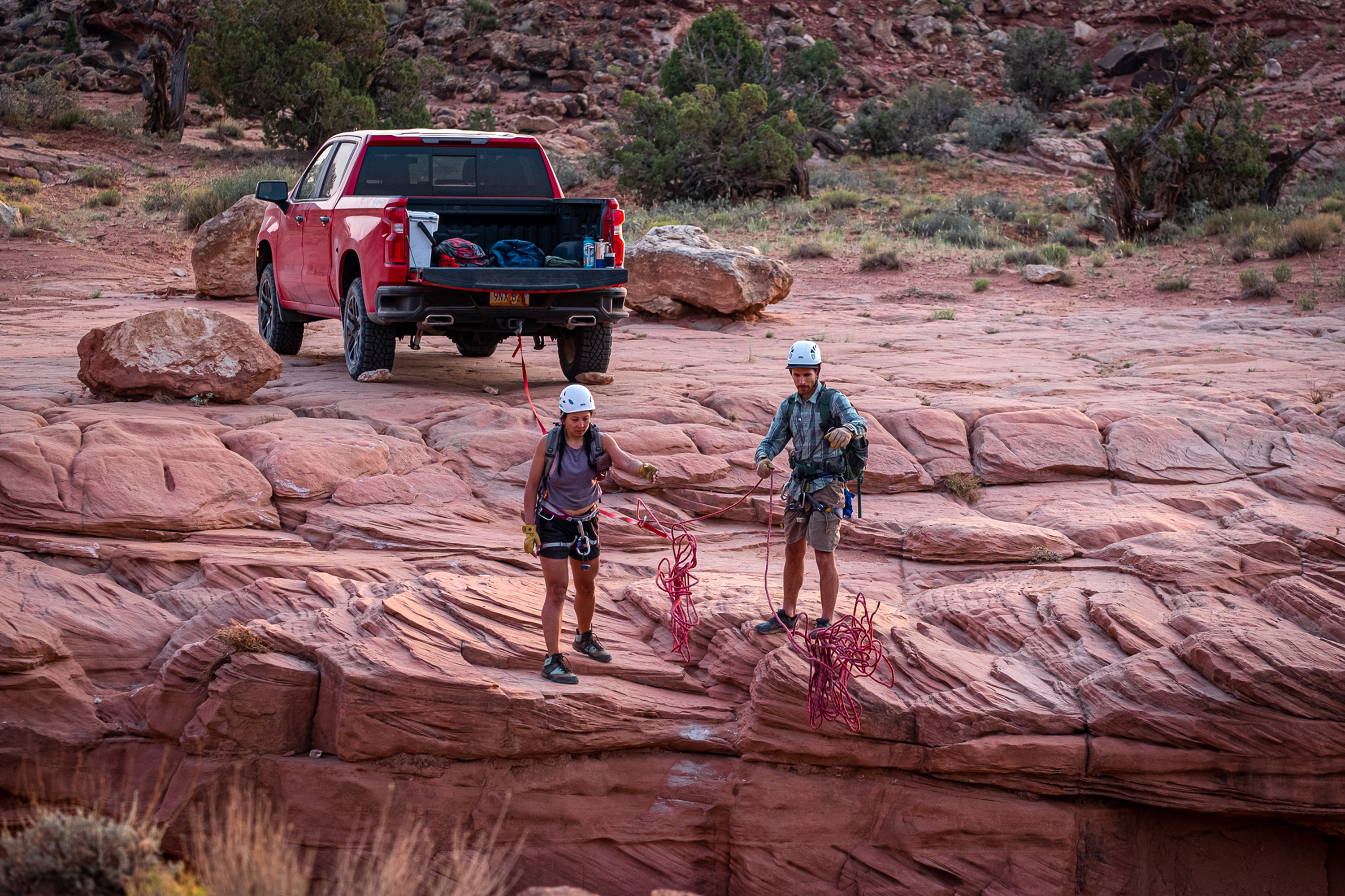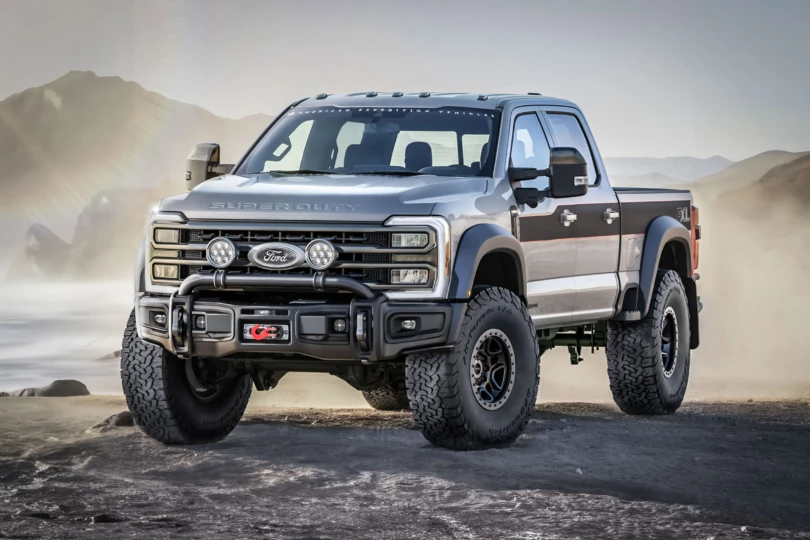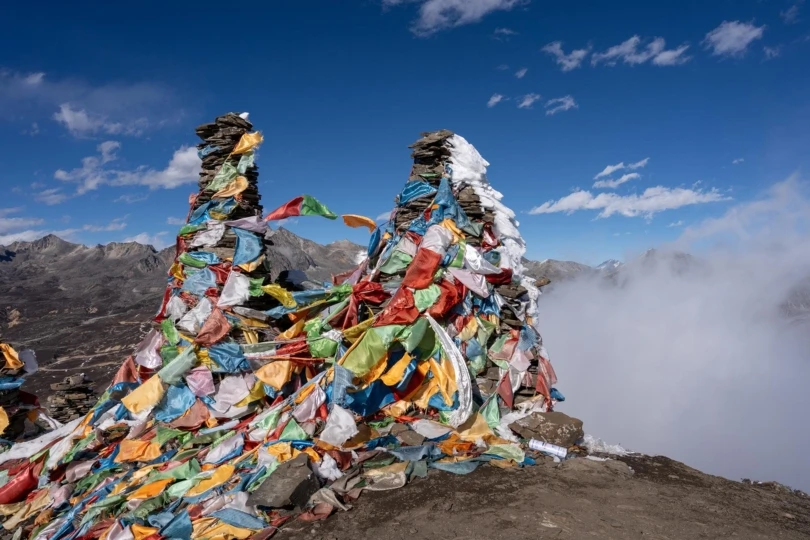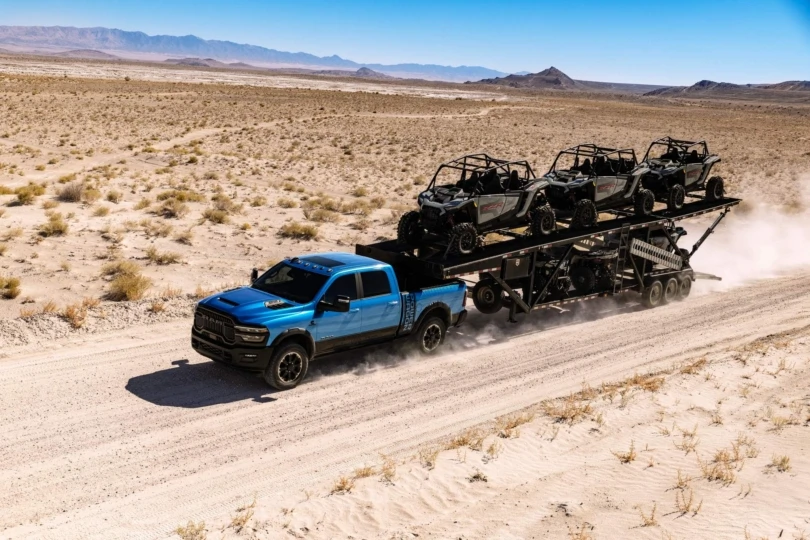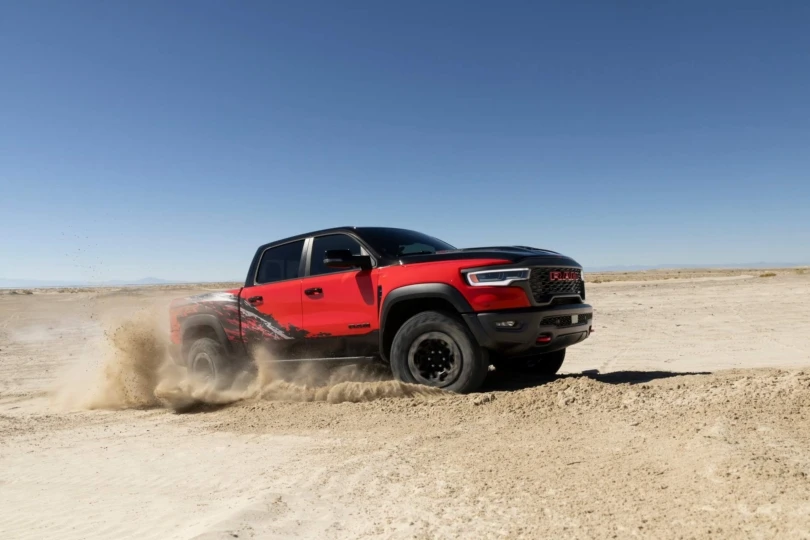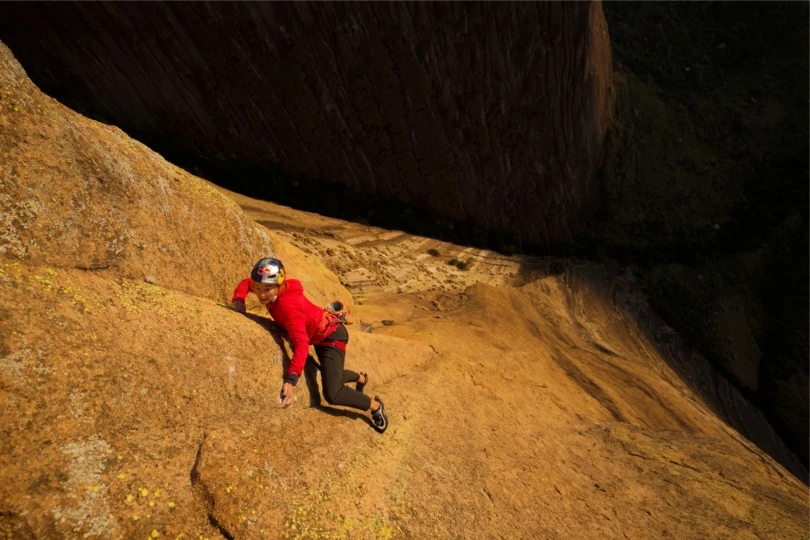Drop into and crawl through high-walled rock formations virtually off-limits to traditional hikers. Looking for a unique way to interact with the landscape and unlock its hidden features? You may be cut out for canyoneering life.
Canyoneering is a not-so-technical activity for those with some climbing experience — and a fondness for tight spaces. Getting through some canyons takes hiking, shimmying, swimming, rappelling, and more maneuvers to navigate the inconsistent terrain.
The reward for such feats is often the discovery of secret pools of water and wildlife, new perspectives on the desert’s history, and, for some, a welcome sense of solitude.
But first, we have to get there. We follow Chris and Ashley Kasper, the husband-and-wife duo — who own and guide for Outdoor Calling — and their 2021 Chevy Silverado on a canyoneering trip to Utah’s Grand Staircase–Escalante National Monument.
Canyoneering Escalante National Monument
Utah’s canyons are known for their red sandstone walls carved out by millions of years of wind and water. Escalante is slightly less popular than the canyons in and around Zion National Park, which draws canyoneers from across the globe. Escalante’s scenery attracts adventurers who seek more solitude.
The adventure begins before you even get there. The solitude and remoteness of Escalante are the definition of “off the beaten path.” So you’ll want an off-road-capable vehicle to bring you closer to the slot canyons.
The variety of slot canyons in Escalante vary from nontechnical terrain that can be hiked into and out of, some are more climbing-oriented, and others may resemble something more like spelunking. In general, once you move behind hiking access, you’re canyoneering.
“Prior climbing experience is not necessary, but it is beneficial to have experience scrambling on rocks and managing ropes,” said Chris Kasper, who’s canyoneered since childhood.
Experienced canyoneers come prepared to climb, rappel, shimmy, and swim their way through a canyon. However, you need not be an expert at all of these skills to get started exploring slot canyons. That’s where reading up on the routes comes in.

(Photo/Kurt Barclay)
Know Before You Go
Since most canyons are found in remote areas and often in or around national parks, it is important to be prepared to take everything out with you. Using your truck as a base station for gear, food, water, and waste helps follow the Leave No Trace ethos and keep those areas clean.
“If traveling to a remote area to go canyoneering, you should be comfortable with reading and navigating backcountry terrain, first in your vehicle on the way to the trailhead, and second when hiking the approach or exit of the canyon,” Chris recommended.
Exploring areas like Escalante requires a vehicle that is off-road capable with high ground clearance, which will get you closer to the canyons themselves and makes your base more accessible to you.
“Go to the local gear shops, like Utah Canyon Outdoors in Escalante, to ask for advice, buy local guidebooks (don’t just rely on your phone), and pick up extra gear like webbing and quick-links to potentially make new anchors to rappel off of.”
When reading up on routes, check to make sure you don’t need a permit and be mindful of any visitation regulations specific to that area.
From there, it’s important to remind you these canyons don’t have signs or cell service. Once you’re in, you’ll need to navigate on your own. In some canyons, that can mean you just keep going in the same direction you began.
In more technical canyons, there are holes to crawl through and forks in the river to follow. For those, you’ll need experience and confidence in your navigation skills.
A huge factor in the desert is the weather, especially during the monsoon season. Check the weather forecast for the risk of rain, which can cause flash flooding, a particular risk down inside a slot canyon. Keep in mind that rains from miles away can be out of sight and yet empty a deluge of water into a canyon downstream.

Basic Canyoneering Gear
Canyoneering typically involves rope climbing gear. A canyoneering-specific static line, rappel device, carabiners, helmet, and harness all get packed in a bag. Other must-pack items include sunscreen, a first-aid kit, fire tools, shelter, and water. (Did we mention this is the desert?)
Footwear choices tend toward form-fitting trail shoes with rubber soles with low-profile tread for traction. Rock surfaces will be slick or wet, and big lugs mean less surface contact. Since your hands will also be all over that rock, you’ll want to wear gloves, too.

(Photo/Kurt Barclay)
Clothes should be highly breathable and quick-drying. Pants with reinforced knees and bottom are also advised, as scraping against rock is sort of the name of the game here. Always pack spare socks, and since you’re likely bringing a phone or camera, use the socks as padding in a dry bag or case.
For routes with water exposure, especially bouts of swimming or immersion, a wetsuit is needed. Another option is to use a flotation vest to keep your head above water in rough water or just let you ease up and float through some long water crossing.
If you have no climbing (or rappelling) experience, there are guided tours to ease you into the sport with introductory tutorials. These will teach you some basics and reward you with a scenic route through canyons with the ease of mind that you’ll get out without facing troubles.
From there, Kasper recommends starting with “a relatively accessible canyon with smaller rappels and an easy approach and exit so you can get comfortable with your gear, then progress from there.”
Know the Conditions
Slot canyons can get cramped. You should be comfortable in tight spaces as well as physically prepared to shimmy through rock walls in places.
The desert is known for extreme heat and big temperature swings when it cools off. Some canyons can trap heat, but slot canyons typically offer a break from direct sunlight amid desert temperatures. The arid landscape gets cool at night, especially in the canyons and along the river.
That brings us to another factor: water. The river itself can be especially cold, which can be a relief after a day of scrambling and hiking through heat. However, some canyoneering routes require long bouts of swimming, and a wetsuit is needed to stay comfortable and reduce the risk of hypothermia.
Don’t overlook the exit, Chris said. “Make sure you have enough water and snacks for the return trip to the car. Mark your starting point with GPS and pay attention to recognizable features in the landscape.”

Be Safe, Have Fun
The twisting mazes of slot canyons offer a sense of exploration you don’t get on other landscapes. You can’t see too far ahead (or behind) and even a well-studied route can offer surprises.
Flash flooding we covered, but we’ll add the reminder to check for rain in the forecast and ask a ranger (if applicable) to see how much of the surrounding area empties into the canyon you’ll enter. The drainage area can extend miles away in mountainous areas.
With so much of the wilderness explored and posted on social media, slot canyons offer a chance for isolation and an ever-changing experience. Sure, these same areas show up in our feeds and you’ll likely be inspired to share the beauty as well, but chances are you’ll encounter few other people.
Lastly, the Kaspers advised new visitors to be mindful en route.
“When hiking to and from the canyons, avoid trampling fragile biological soil crusts and try not to make any new trails,” Chris said. The desert is full of delicate microfauna that can take years to regrow.
Canyoneering offers a new look at rugged landscapes and far-off locations that can be a welcome escape from the noise of daily life.
This article is sponsored by the 2021 Chevy Silverado – Find New Roads. Learn more about the 2021 Chevy Silverado and more truck models online.
